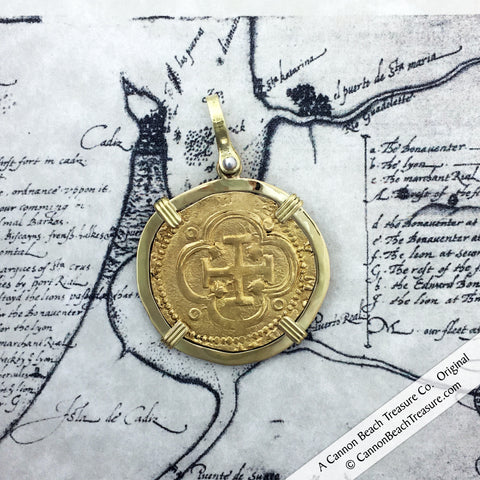 No other coin is quite so legendary - or quite so regal - as the glittering 22K gold doubloon.
No other coin is quite so legendary - or quite so regal - as the glittering 22K gold doubloon.
Desired above all other currency by kings, princesses, pirates, privateers and adventurers for centuries, this stunning example of the coin-minters art is the unquestioned treasure coin to end all treasure coins!
Gold “doubloons” and silver “Pieces of 8” have been washing up on the shores of the Bay of Cadiz for hundreds of years! This precious treasure coin was among them!
As the Age of Discovery (the early 15th Century to the early 17th Century) dawned and flourished, the Portuguese and Spanish pioneered long-distance maritime travels in search of alternative trade routes to “the Indies,” and a fabled endless supply of gold, silver and spices. The Age of Discovery was the bridge between the Middle Ages and the Modern era, and, along with the contemporary Renaissance movement, triggered the early Modern period and the rise of European nation-states.
By the 15th Century, the overland Silk Road and oceanic Spice Trade routes had been established for hundreds of years, but they were blocked by the Ottoman Empire (1299 – 1923) in 1453 with the conquest of Constantinople. This spurred exploration to find alternative sea routes.
By then, Europeans had developed an insatiable desire for precious metals – especially gold. Ahhh… gold. Not only was it pleasing to gaze upon and warm to hold, but in the form of coins, Europeans believed it had the almost magical ability to be exchanged for virtually any commodity, anywhere in the world, at any time. And the exotic, unexplored lands from whence much of the gold came only added to this mystique.
We can never know the individual stories of the gold escudos discovered on the shores of Cadiz Bay, but when we consider the dates the coins were minted, we certainly can extrapolate a few things. The gold in the Philip II escudos were more than likely from New World mines, and were transported as bullion bars, since the first Spanish colonial gold coins were not minted in Mexico City until 1622, when Atocha made her fateful journey.
For nearly 300 years Cadiz bay was a major port for Spanish treasure galleons departing and returning from the New World - hundreds sank in the bay over these centuries. In 1587 the British privateer Sir Frances Drake sailed into the Bay of Cadiz and attacked the Spanish Armada that was preparing to attack England. These coins may be from some of those galleons!
Personal Note from Robert: Even though I have been in and around the “treasure business” on and off for 30 years, it never ceases to amazing me with the connections we have with treasure. During the summer of 2017, a retired gentleman came into our store in Cannon Beach. He became particularly excited when he saw our Treasure of Cadiz Bay exhibit. “I was stationed there in the 1970s and used to walk along those beaches,” he told me. “The locals would find old coins like these and I even found a couple myself!”
To see our full collection of Cadiz Bay Spanish gold coins, click here>
